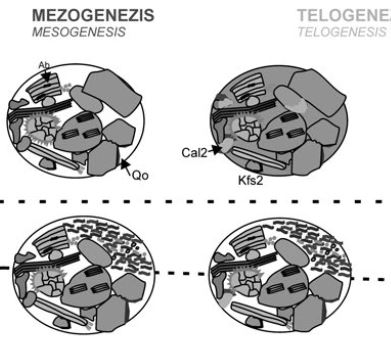Diagenetic evolution of the Lower Miocene Pétervására Sandstone Formation
Abstract
For this paper, the Eggenburgian Pétervására Sandstone — a shallow marine siliciclastic formation — was studied as a surface analogue for known reservoir rocks. Field observation in the area of Kishartyán, detailed petrography (including SEM, CL) and geochemical analysis (XRD, SEM-EDS, stable isotope analysis) were applied to find out more about the diagenetic processes, the burial history, the porosity evolution, and their relationship with the weathering forms. The composition of the fine to very coarse-grained sandstones varies between subarenite and litharenite. The most common detrital grains are mono- and polycrystalline quartz and sedimentary rock fragments (cherts, dolomites and metamorphic rock fragments). Ductile grains are represented by micas and altered volcanoclastic rock fragments. Based on the proportion of components, four lithofacies were distinguished: porous sandstone (LF1), matrix-rich sandstone (LF2), cement-rich sandstone (LF3), and matrix and cement rich sandstone (LF4). The eogenetic minerals are: glauconite, framboidal pyrite, flattened rhombohedral siderite crystals, K-feldspar overgrowth cement, kaolinite, and (supposedly) small amounts of calcite. The maximum burial temperature was likely reached at around 80 °C; this is indicated by the presence of quartz overgrowth cement, mixed layer illite/smectite, and replacive and cementing albite. These minerals were formed in the mesogenetic realm. During eogenesis and mesogenesis, the porosity of the sandstone progressively
decreased due to compaction and the precipitation of authigenic minerals. Calcite is one of the latest diagenetic minerals and occurs both as a replacive phase and as cement. The distribution of calcite within the studied sandstone is heterogeneous. Calcite is present in elongated lenses where the sandstone has a very low porosity. Considering the geochemical data and the geological setting, the origin of the calcite can be explained by several genetic models. According to these models, the formation of the calcite may have taken place either in the mesogenetic realm from
modified marine pore waters (buried together with the sediment), or from an exotic fluid channelled along fault zones. In the second scenario, there are two possibilities regarding the origin of the parent fluid: namely, (a) a formational fluid or (b) a deeply circulated, warmed-up meteoric fluid. The high porosity of the sandstone is the result of dissolution by meteoric water during uplift. Diagenetic evolution of the sandstone had a crucial role in the formation of the weathering morphology.












